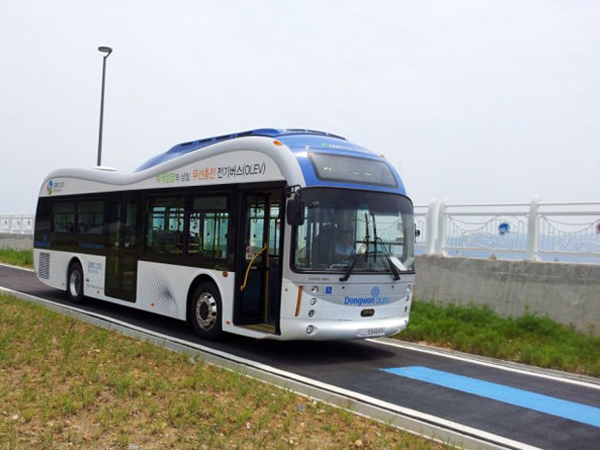The Korea Advanced Institute of Science and Technology (KAIST) is quite a major believer in the concept of the Online Electric Vehicle (OLEV), which promotes the idea of an electric vehicle that can be charged while stationary or driving, thus removing the need to stop at a charging station. This is done through recharging the on-board batteries via special plates underneath the vehicle that use magnetism to literally “collect” electricity from power strips or cables buried underground as it passes overhead. The Institute has been doing this for a few years with a tram at an amusement park, and its technology was more recently recognized by the World Economic Forum as among the most promising of this year.
KAIST is now taking its OLEV wireless charging technology to the next level, working with the South Korean city of Gumi to outfit two mass transit electric buses in a field pilot. They run an inner city route between Gumi Train Station and In-dong district, for a total of 24 km (14.9 miles) round trip. Each bus receives 20 kHz and 100 kW (136 horsepower) electricity at an 85% maximum power transmission efficiency rate, according to researchers, while maintaining a 17 cm air gap between the underbody of the vehicle and the road surface.

The OLEV footprint is relatively small both on the vehicles and also in the road itself. The batteries on the buses, for example, are about one third the size of a battery on a regular electric car, while the “length of power strips installed under the road is generally 5%-15% of the entire road, requiring only a few sections of the road to be rebuilt with the embedded cables.”
And, in a power savings function, the road has a so-called smart design, whereby it distinguishes OLEV buses from regular cars. When an equipped bus goes overhead, the power strip is switched on, but it then switches off afterwards and remains off even non-equipped vehicles pass overheard. In this way not only is energy saved, but EMF exposure is prevented.
Assuming the buses do well in trials, Gumi plans to add 10 more by the end of 2015.
“It’s quite remarkable that we succeeded with the OLEV project so that buses are offering public transportation services to passengers,” said Dong-Ho Cho, the director of the Center for Wireless Power Transfer Technology Business Development at KAIST, in a statement. “This is certainly a turning point for OLEV to become more commercialized and widely accepted for mass transportation in our daily living.”